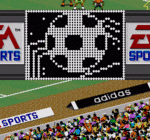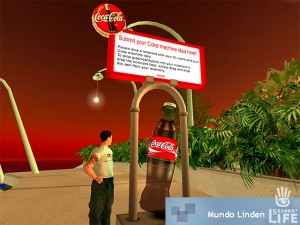Branding on Virtual Worlds
by CheekyGuy, HSM team writer
If you take a close enough look, most popular video games today now show advertisements from real-world commercial brands. Given the costs incurred by producing some of the latest gaming blockbusters (Gran Turismo 5 comes immediately to mind), not to mention the amount of time an average gamer spends in-game, this really isn’t a surprise.
However, developers have been doing this for years. When you look at games from earlier times (mostly in arcade games) you would see billboards featuring ‘in-game’ advertising of that software developer’s next big game.
For example, on Sports titles such as EA’s FIFA Soccer series, you can clearly see advertisements donning the sidelines with sportswear such as Adidas in its 1994 edition. The 1992 PC platform title Zool was another earlier example to feature an IGA (In Game Advertisement) with third-party sponsorship to feature the Chupa Chups marketing brand.

In October 2008, billboard ads featuring US Democratic Presidential candidate Barack Obama appeared in Burnout: Paradise, which was first released in January of that year. Electronic Arts (EA), the game’s publisher, confirmed that the Obama campaign paid for the advertisements, making it the first time that a US presidential candidate has bought in-game advertising.
So, you ask yourself, isn’t it just a matter of time before Sony begins using ‘in world’ advertising on PlayStation Home for many of its other products, besides gaming?
It’s already done this to a small degree in Japan Home, and it’s already shown it can promote huge heavy-hitters with it’s recent campaign of Killzone 3 by completely re-designing Central Plaza. But wouldn’t it be great to see commercial branding from third parties like McDonald’s or Nike Sportswear? Wouldn’t you like to see your avatar in commercially recognized sportswear? In North America Home, sandwich chain Subway has been running their Footlong Nation game for the past two years, and others are climbing on board as well. In Europe Home, car manufacturer Audi has their own stunning space and game for people to play.
On ‘rival world’ Second Life, I have seen branding as far as Coca Cola — or, at least, a cheap knock-off of Adidas. There are other recognisable brands such as American Apparel, Toyota, Lego and others, some of which can pass you by without batting an eyelid whether it was meant to be there or not.
But people go to it, because they recognize it, they are familiar with it, and in doing so, believe more in the game world they exist in. Why? Because suddenly that world has become relatable.
If you’re a software developer getting sponsorship from a third-party company – regardless of what shape or form – isn’t it logical to credit them in some way?
A number of games utilize blatant product placement for the purpose of creating a more realistic gaming environment.
One example is hip street-racing game Midnight Club: Los Angeles from Rockstar Games, which saw street-racing fans zip from one end of the sprawling City of Angels to the other in tricked-out exotic tuner cars, all the while talking smack to each other on their T-Mobile cell phones, featuring the famous five-tone T-Mobile jingle during gameplay.
A study published in the summer of 2008 by Nielsen Games and Nielsen BASES, commissioned by IGA Worldwide, found that the majority of gamers – eighty-two percent – had no problem with in-game ads, which the research found to be more effective than messages appearing in traditional media.
Would you be interested in a product if it was presented to you ‘in-game’ or ‘in-world’ on PlayStation Home? Would you buy a virtual product that you can see yourself recognizing? Perhaps in Home, you could go to the Mall and purchase a Sony-branded “virtual” MP3 player for your avatar, with which you can play a playlist that you have saved onto your HDD and play – for yourself – while walking around in a public space, without disturbing anybody else? And, much like in real life, you avatar would appear to be wearing earpieces.
Or how about being able to go to a Starbucks in the Mall? No, your avatar can’t eat or drink, so on the surface, such a notion sounds ridiculous. But people who go into a Starbucks don’t go there just for the coffee, either – that’s what the drive-thru window is for – they go for the social experience. Much like in Home.
We may yet reach the point where there are personalized ads, similar to what Tom Cruise experienced in Minority Report, bombarding us from every direction. To a certain extent, Facebook is already notorious for this. While Home may not have the technological capability to achieve this, some future iteration of virtual reality may see such things as commonplace.








The NA Home has been doing this since day one actually. One of the accessories that your avatar is given when you start is a pair of Sony headphones (I forget the exact model) that you can wear, but they don’t function as anything other than decoration and advertising.
Also, Slurpee has been advertising their frozen sugar water for quite a while with a points system on their site you can use to buy virtual items for your avatar. First one I got from them was a black hoodie with a red SLURPEE across the front. They had items for God of War III (tee shirts for Home and unlockables for the game), and now for Killzone 3 and Little Big Planet 2 as well (counter top Slurpee machines for your Home space, themed for each game).
Also, in recent months we’ve seen items/spaces/promotions for auto makers (Scion, Ford, Toyota) and theatrical releases (Ghostbusters, Star Wars, Indiana Jones, The A-Team). It also permeates the PlayStation Network with content being provided by 5 gum, Toyota Highlander and Crackle, Mountain Dew, etc.
There’s advertising all around us when we pick up our Dual Shock 3 controllers, but how much are we really paying attention to?
Personally, I don’t mind a bit of in-Home (or in-game for that matter) advertising. It does generate revenue for Home as a whole, which allows for the continuation and growth of the project. But the selling of virtual ad-space also brings up a host of concerns as well.
Internet advertising has become very user-targeted; huge amounts of personal data is captured, stored, and sold for the use of targeting ads to people who would be the most interested. While on the surface this may not seem like too bad a thing, if one looks deeper the loss of privacy is shocking.
I know that every time I use my web browser, every site I visit, every article I view, every purchase I make is compiled somewhere along the line by the business and advertising industry or some government agency. Needless to say, I am somewhat uncomfortable with this level of scrutiny into my daily life. I’m unsure if Home has already started such data collection (I’ve not received any targeted advertising from Home or Sony as of yet), but given the current widespread usage of such technology I fear it almost an inevitability that the same would be used for Home if advertising becomes a larger (or main) source of revenue.
The US military is no stranger to web advertising and the gaming culture and industry. The Pentagon spends a huge amount of advertising dollar on-line (and even has brought games to market – The America’s Army series – as well as budgeted an astonishing 50 million dollars plus, according to Stars and Stripes , for the in-house development of their own FPS they use for training) and has had great success in recruiting via the net. Home (moreso with the upcoming 1.5 update which may allow for full multiplayer gaming experiences) would seem to me to be a perfect place for the Pentagon to set up a public space (complete with games and rewards) to not only recruit, but to plant the seed in younger minds.
I don’t have a problem with the military advertising itself, per se. But I would be against such a space in Home, much as I am against military recruitment in public schools. The realities of war and combat have already become a nebulous, dreamy, and game-like experience in the minds of many; I believe that a Home space would lead to an even greater blurring of this line.
Also of concern would be the sheer amount of ads which would be thrown at a Home user if the amount of advertising went unchecked. Setting up a space or event is a great idea (gives us Home inhabitants something to do even if we decide not to consume the product…I STILL don’t drink Red Bull :>), but how long before we might see ‘pop-up’ type ads as we log-into home or simply mill about a space ?
Obviously, there’s a not-too-fine-line between a tasteful amount of advertising and complete overkill. Let’s hope that those who will shape and form the future of Home don’t make the fiscal bottom line the ONLY line to base their decisions on.
The military in home,too bad the 3rd amendment of the constitution would not apply there.I only hope that if that comes about differing opinions will be allowed.The military normally crushes opposition so any deal with them might force any alternative viewpoints from being displayed.Having said that i’m actually in favor of a strong military,i just see the way it’s being incompetently handled by political leaders to solve any difficult problem as troublesome.The military angle could be used to push onto gamers the idea that these wars we are in are good,right,or even in the case of some not illegal under the U.N. charter.Government sponsered mind,i hesitate to use the word control,influence to push any assinine idea onto gamers is a scary thought indeed.
I don’t know if this what the article is talking about but I remember seeing a Shakira video in the theatre that I did not like one little bit at all.
However, there was at least one person who constantly talked about wanting more of her videos so out of curiosity I looked up some of her songs online and found one that I liked a lot, “Illegal”.
The above is perhaps a combination of advertisement and word of mouth from Home forum users.
I ended up buying Shakira’s “Waka Waka” because of the FEVA area although I’m not sure that’s a case of advertising. (Yeah, it is.) So that’s two of her songs I bought. Probably won’t buy anymore but advertising and world of mouth does work sometimes if a peoples likes a product or in this case music.
That’s all.